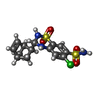[English] 日本語
 Yorodumi
Yorodumi- PDB-7tnj: Complex NNNN of AMPA-subtype iGluR GluA2 in complex with auxiliar... -
+ Open data
Open data
- Basic information
Basic information
| Entry | Database: PDB / ID: 7tnj | |||||||||||||||
|---|---|---|---|---|---|---|---|---|---|---|---|---|---|---|---|---|
| Title | Complex NNNN of AMPA-subtype iGluR GluA2 in complex with auxiliary subunit gamma2 (Stargazin) at low glutamate concentration (20 uM) in the presence of cyclothiazide (100 uM) | |||||||||||||||
 Components Components | Isoform Flip of Glutamate receptor 2,Voltage-dependent calcium channel gamma-3 subunit chimera | |||||||||||||||
 Keywords Keywords | MEMBRANE PROTEIN / AMPA / iGluR / Stargazin / cryo-EM / complex / agonist / positive allosteric modulator / subconductance level / opening / gating / glutamate | |||||||||||||||
| Function / homology |  Function and homology information Function and homology informationpostsynaptic neurotransmitter receptor diffusion trapping / regulation of AMPA receptor activity / Trafficking of AMPA receptors / channel regulator activity / LGI-ADAM interactions / neurotransmitter receptor localization to postsynaptic specialization membrane / transmission of nerve impulse / AMPA glutamate receptor complex / excitatory synapse / positive regulation of synaptic transmission, glutamatergic ...postsynaptic neurotransmitter receptor diffusion trapping / regulation of AMPA receptor activity / Trafficking of AMPA receptors / channel regulator activity / LGI-ADAM interactions / neurotransmitter receptor localization to postsynaptic specialization membrane / transmission of nerve impulse / AMPA glutamate receptor complex / excitatory synapse / positive regulation of synaptic transmission, glutamatergic / protein targeting / voltage-gated calcium channel activity / somatodendritic compartment / ionotropic glutamate receptor binding / PDZ domain binding / postsynaptic density membrane / Schaffer collateral - CA1 synapse / intracellular protein localization / dendrite / glutamatergic synapse Similarity search - Function | |||||||||||||||
| Biological species |  | |||||||||||||||
| Method | ELECTRON MICROSCOPY / single particle reconstruction / cryo EM / Resolution: 4.02 Å | |||||||||||||||
 Authors Authors | Yelshanskaya, M.V. / Sobolevsky, A.I. | |||||||||||||||
| Funding support |  United States, 4items United States, 4items
| |||||||||||||||
 Citation Citation |  Journal: Nature / Year: 2022 Journal: Nature / Year: 2022Title: Opening of glutamate receptor channel to subconductance levels. Authors: Maria V Yelshanskaya / Dhilon S Patel / Christopher M Kottke / Maria G Kurnikova / Alexander I Sobolevsky /  Abstract: Ionotropic glutamate receptors (iGluRs) are tetrameric ligand-gated ion channels that open their pores in response to binding of the agonist glutamate. An ionic current through a single iGluR channel ...Ionotropic glutamate receptors (iGluRs) are tetrameric ligand-gated ion channels that open their pores in response to binding of the agonist glutamate. An ionic current through a single iGluR channel shows up to four discrete conductance levels (O1-O4). Higher conductance levels have been associated with an increased number of agonist molecules bound to four individual ligand-binding domains (LBDs). Here we determine structures of a synaptic complex of AMPA-subtype iGluR and the auxiliary subunit γ2 in non-desensitizing conditions with various occupancy of the LBDs by glutamate. We show that glutamate binds to LBDs of subunits B and D only after it is already bound to at least the same number of LBDs that belong to subunits A and C. Our structures combined with single-channel recordings, molecular dynamics simulations and machine-learning analysis suggest that channel opening requires agonist binding to at least two LBDs. Conversely, agonist binding to all four LBDs does not guarantee maximal channel conductance and favours subconductance states O1 and O2, with O3 and O4 being rare and not captured structurally. The lack of subunit independence and low efficiency coupling of glutamate binding to channel opening underlie the gating of synaptic complexes to submaximal conductance levels, which provide a potential for upregulation of synaptic activity. | |||||||||||||||
| History |
|
- Structure visualization
Structure visualization
| Structure viewer | Molecule:  Molmil Molmil Jmol/JSmol Jmol/JSmol |
|---|
- Downloads & links
Downloads & links
- Download
Download
| PDBx/mmCIF format |  7tnj.cif.gz 7tnj.cif.gz | 452.8 KB | Display |  PDBx/mmCIF format PDBx/mmCIF format |
|---|---|---|---|---|
| PDB format |  pdb7tnj.ent.gz pdb7tnj.ent.gz | 348.1 KB | Display |  PDB format PDB format |
| PDBx/mmJSON format |  7tnj.json.gz 7tnj.json.gz | Tree view |  PDBx/mmJSON format PDBx/mmJSON format | |
| Others |  Other downloads Other downloads |
-Validation report
| Summary document |  7tnj_validation.pdf.gz 7tnj_validation.pdf.gz | 1.2 MB | Display |  wwPDB validaton report wwPDB validaton report |
|---|---|---|---|---|
| Full document |  7tnj_full_validation.pdf.gz 7tnj_full_validation.pdf.gz | 1.2 MB | Display | |
| Data in XML |  7tnj_validation.xml.gz 7tnj_validation.xml.gz | 69.4 KB | Display | |
| Data in CIF |  7tnj_validation.cif.gz 7tnj_validation.cif.gz | 105.6 KB | Display | |
| Arichive directory |  https://data.pdbj.org/pub/pdb/validation_reports/tn/7tnj https://data.pdbj.org/pub/pdb/validation_reports/tn/7tnj ftp://data.pdbj.org/pub/pdb/validation_reports/tn/7tnj ftp://data.pdbj.org/pub/pdb/validation_reports/tn/7tnj | HTTPS FTP |
-Related structure data
| Related structure data |  26011MC  7tnkC 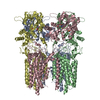 7tnlC 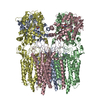 7tnmC 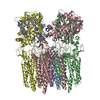 7tnnC 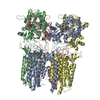 7tnoC 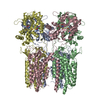 7tnpC C: citing same article ( M: map data used to model this data |
|---|---|
| Similar structure data | Similarity search - Function & homology  F&H Search F&H Search |
- Links
Links
- Assembly
Assembly
| Deposited unit | 
|
|---|---|
| 1 |
|
- Components
Components
| #1: Protein | Mass: 115444.922 Da / Num. of mol.: 4 Source method: isolated from a genetically manipulated source Source: (gene. exp.)   Homo sapiens (human) / References: UniProt: P19491-2, UniProt: Q8VHX0 Homo sapiens (human) / References: UniProt: P19491-2, UniProt: Q8VHX0#2: Chemical | ChemComp-CYZ / Has ligand of interest | Y | Has protein modification | Y | |
|---|
-Experimental details
-Experiment
| Experiment | Method: ELECTRON MICROSCOPY |
|---|---|
| EM experiment | Aggregation state: PARTICLE / 3D reconstruction method: single particle reconstruction |
- Sample preparation
Sample preparation
| Component | Name: Ionotropic glutamate receptor GluA2 in complex with auxiliary subunit gamma2 or Stargazin Type: COMPLEX / Entity ID: #1 / Source: RECOMBINANT |
|---|---|
| Source (natural) | Organism:  |
| Source (recombinant) | Organism:  Homo sapiens (human) Homo sapiens (human) |
| Buffer solution | pH: 8 |
| Specimen | Embedding applied: NO / Shadowing applied: NO / Staining applied: NO / Vitrification applied: YES |
| Vitrification | Cryogen name: ETHANE |
- Electron microscopy imaging
Electron microscopy imaging
| Experimental equipment |  Model: Titan Krios / Image courtesy: FEI Company |
|---|---|
| Microscopy | Model: FEI TITAN KRIOS |
| Electron gun | Electron source:  FIELD EMISSION GUN / Accelerating voltage: 300 kV / Illumination mode: FLOOD BEAM FIELD EMISSION GUN / Accelerating voltage: 300 kV / Illumination mode: FLOOD BEAM |
| Electron lens | Mode: BRIGHT FIELD / Nominal defocus max: 2500 nm / Nominal defocus min: 1000 nm |
| Image recording | Electron dose: 58.5 e/Å2 / Film or detector model: GATAN K3 (6k x 4k) |
- Processing
Processing
| CTF correction | Type: PHASE FLIPPING ONLY |
|---|---|
| 3D reconstruction | Resolution: 4.02 Å / Resolution method: FSC 0.143 CUT-OFF / Num. of particles: 49098 / Symmetry type: POINT |
 Movie
Movie Controller
Controller








 PDBj
PDBj


